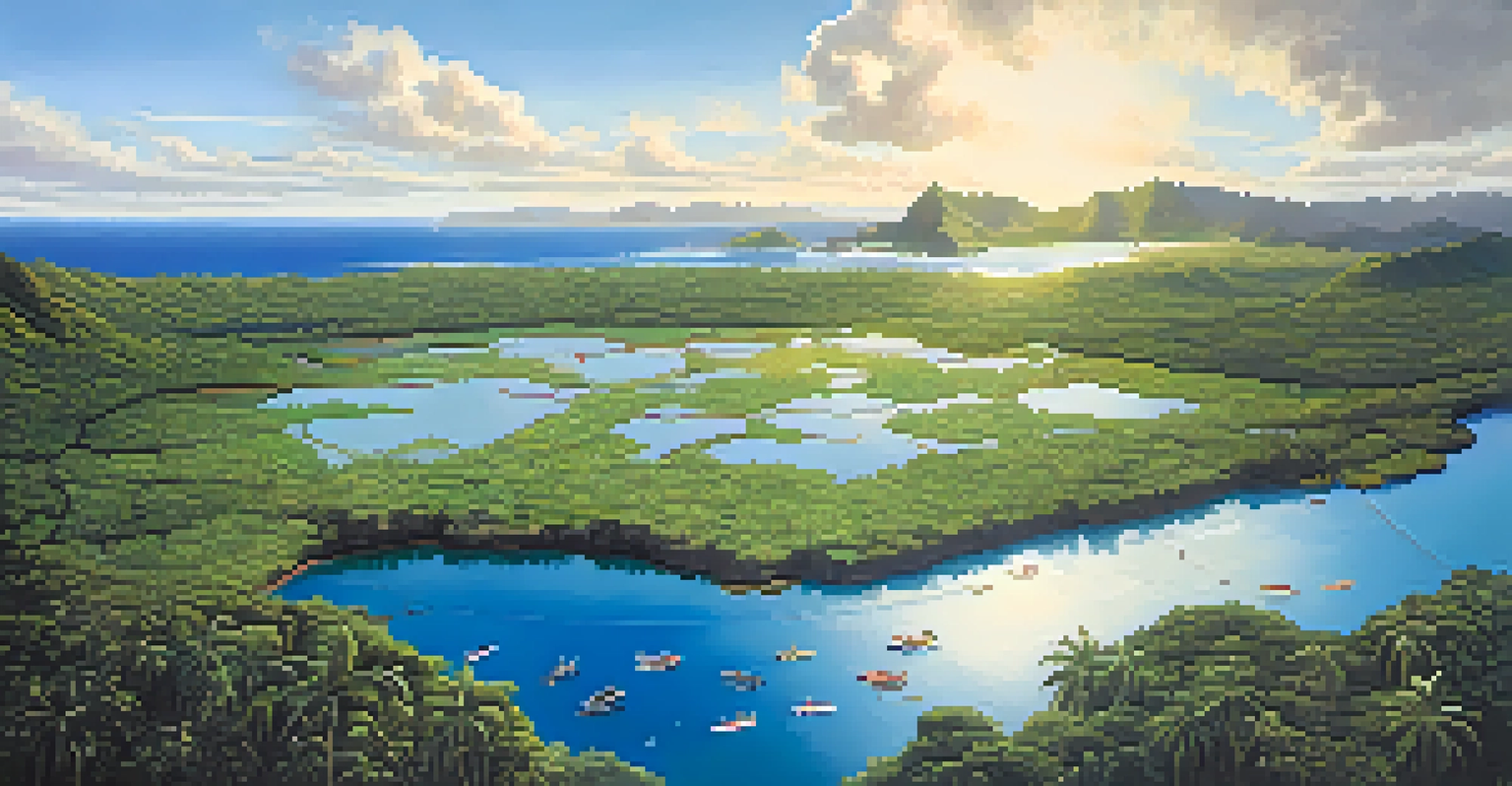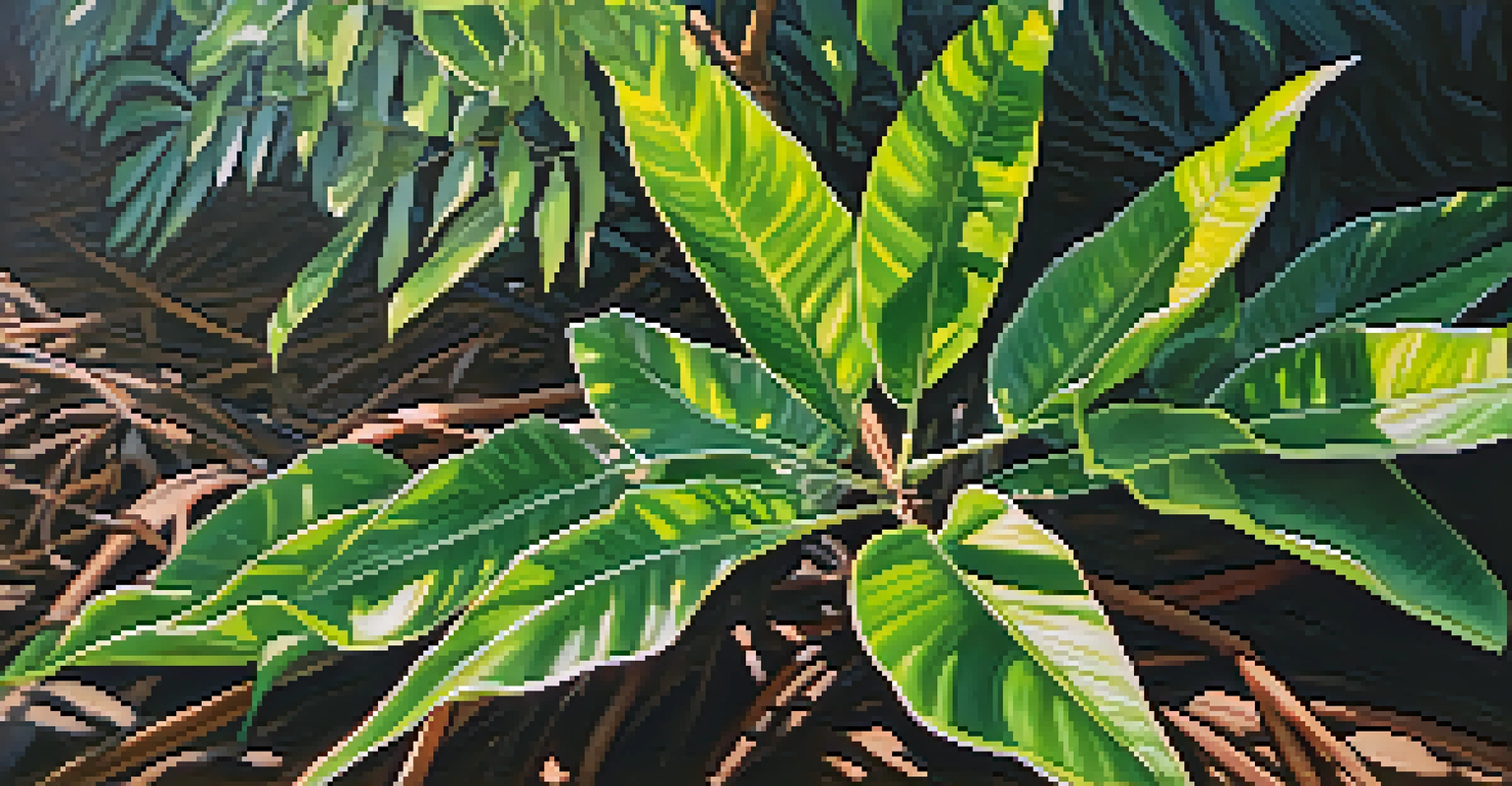Environmental History: Land Use and Preservation in Hawaii

The Unique Landscape of Hawaii: A Historical Overview
Hawaii's landscape is a stunning tapestry of diverse ecosystems, shaped by volcanic activity and oceanic currents. Understanding its environmental history requires us to look back at how these natural elements influenced human settlement and land use. From early Polynesian navigators to modern-day residents, the way land has been utilized reflects a deep connection to nature and resources.
The land is alive, and we must treat it as such. It sustains us, and in return, we must sustain it.
Initially, Polynesians practiced sustainable agriculture, cultivating taro and sweet potatoes in harmony with the island's ecosystems. Their methods were not just survival strategies but also spiritual practices, illustrating respect for the land. This relationship set a foundation for land use that prioritized preservation and sustainability, an ethos that's still relevant today.
However, with the arrival of Western settlers in the 18th century, land use began to shift dramatically. The introduction of plantation agriculture and commercial farming led to significant environmental changes, including deforestation and habitat destruction. This period marked the beginning of a complex relationship between development and preservation that continues to challenge Hawaii's environment.
Traditional Practices: Sustainable Land Management
The traditional practices of Native Hawaiians offer valuable lessons on sustainable land management. They employed techniques such as 'ahuʻula and loko iʻa, which are systems of fishponds and terraced farming that maximized productivity while minimizing environmental impact. These practices exemplified a deep understanding of the land and its resources, ensuring that the ecosystems remained healthy and resilient.

Native Hawaiians viewed land as a living entity, deserving of respect and care. This perspective fostered a communal approach to land use, where families and communities worked together to sustain resources for future generations. Such practices contributed to biodiversity and the preservation of native species, a stark contrast to industrial practices that often prioritize short-term gains.
Sustainable Practices Shape Land Use
Traditional Hawaiian agricultural methods emphasize respect for the land and sustainability, offering valuable insights for modern conservation efforts.
Today, there is a growing recognition of the importance of these traditional practices in contemporary land management strategies. Efforts to integrate indigenous knowledge into modern conservation initiatives highlight the potential for a more sustainable future. By honoring these traditions, Hawaii can forge a path that respects its past while addressing current environmental challenges.
Colonial Impact on Land Use: A Shift in Paradigm
Colonization brought profound changes to Hawaii's land use, as Western powers prioritized agriculture and economic exploitation over sustainability. The establishment of sugar plantations transformed vast areas of land into monoculture fields, which disrupted local ecosystems and led to soil degradation. This shift not only altered the landscape but also impacted the cultural practices tied to land management.
In every walk with nature, one receives far more than he seeks.
The imposition of private land ownership further complicated traditional land use practices. Native Hawaiians found themselves marginalized, losing access to their ancestral lands and the resources they relied upon. This period marked a significant departure from the communal stewardship that had characterized Hawaiian land management for centuries.
As a result, the struggle for land rights and preservation has been a central theme in Hawaii's history. Movements for sovereignty and environmental justice have emerged, seeking to restore indigenous practices and protect the islands' unique ecosystems. This ongoing battle underscores the importance of recognizing historical injustices while advocating for sustainable land use.
Modern Conservation Efforts in Hawaii
In recent decades, Hawaii has seen a resurgence in conservation efforts aimed at protecting its unique biodiversity. Organizations and local communities have come together to restore native habitats and endangered species, often using traditional practices as a guiding framework. These efforts highlight the importance of collaboration between scientists, policymakers, and indigenous communities.
One successful initiative is the reforestation of native trees, which not only restores habitats but also helps combat climate change. By planting native species, such as koa and ohia, these projects aim to revive ecosystems that have been decimated by invasive species and industrial agriculture. This approach emphasizes the interconnectedness of land health and community well-being.
Colonialism Disrupted Indigenous Practices
The arrival of Western settlers transformed land use in Hawaii, leading to environmental degradation and the marginalization of Native Hawaiian stewardship.
Additionally, marine conservation has become a focal point, with efforts to protect coral reefs and fisheries. These initiatives underscore the critical role that healthy oceans play in sustaining Hawaii's culture and economy. As locals and visitors alike engage in these conservation efforts, the narrative of preservation is gradually shifting toward a collective responsibility to protect Hawaii's environment.
The Role of Invasive Species in Land Use Challenges
Invasive species pose one of the most significant challenges to Hawaii's ecosystems, radically altering land use and conservation efforts. Non-native plants and animals often outcompete native species, leading to a decline in biodiversity. This disruption not only affects the environment but also threatens the cultural practices that rely on native flora and fauna.
Efforts to manage invasive species have become a priority for conservationists in Hawaii. Programs focused on eradication and control are essential to protect vulnerable ecosystems from further degradation. However, these initiatives require considerable resources and community engagement to be effective, highlighting the need for a collective approach to environmental stewardship.
Moreover, the introduction of new invasive species through tourism and trade continues to pose risks. This reality underscores the importance of education and awareness among residents and visitors alike. By fostering a culture of respect for Hawaii’s natural environment, the community can play a pivotal role in mitigating the impacts of invasive species.
Climate Change: A Growing Concern for Hawaii's Land
Climate change presents an unprecedented challenge for Hawaii, affecting land use, ecosystems, and communities. Rising sea levels threaten coastal areas, while increased temperatures and changing precipitation patterns impact agriculture and natural habitats. This reality demands urgent action and innovative solutions to safeguard Hawaii's environment and cultural heritage.
Local farmers are adapting to these changes by implementing more resilient agricultural practices, such as diversifying crops and utilizing water conservation techniques. These adaptations not only help mitigate the impacts of climate change but also promote sustainable land use that honors traditional methods. The resilience of the agricultural sector is crucial for ensuring food security and preserving cultural identity.
Climate Change Demands Urgent Action
Hawaii faces significant challenges from climate change that require innovative solutions and community engagement to protect its unique ecosystems.
Communities are also coming together to address the impacts of climate change through education and advocacy. Initiatives that encourage sustainable practices, such as reducing waste and promoting renewable energy, are becoming increasingly important. By fostering a sense of shared responsibility, Hawaii can work towards a future where both the land and its people thrive despite the challenges posed by climate change.
Looking Ahead: The Future of Land Use and Preservation
As Hawaii navigates the complex interplay between development and preservation, the future of land use will depend on collaboration and innovation. Emphasizing sustainable practices that integrate traditional knowledge with modern science will be key to achieving long-term environmental goals. This holistic approach can help ensure that Hawaii's unique ecosystems are protected for future generations.
Community engagement is critical in this process, as local voices and perspectives often lead to the most effective conservation strategies. By involving indigenous communities in decision-making, Hawaii can honor its rich cultural heritage while addressing contemporary environmental challenges. This partnership can create a sense of ownership and empowerment among residents, fostering a stronger commitment to preservation.

Ultimately, the future of Hawaii's land use will require a balance between economic development and environmental stewardship. By embracing sustainable practices and prioritizing conservation, Hawaii can serve as a model for other regions facing similar challenges. The journey towards a more sustainable future is not just about protecting the land; it’s about nurturing the connection between people, culture, and the environment.